SUUNTO Zoop User Manual [ru]

EN
SUUNTO
ZOOP
USER’S GUIDE
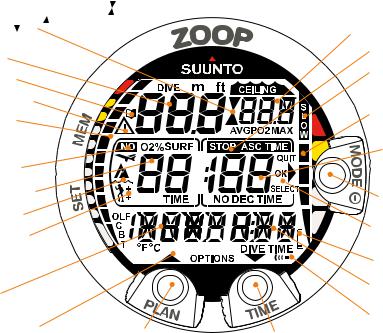
Quick reference guide ZOOP
Arrows:
- Decompression Stop at the Ceiling Depth
- Mandatory Safety Stop Zone
- Ascent Recommended
- Must Descend
Present Depth
Dive Counter
Logbook Symbol
Dive Attention Symbol
Bar Graph:
- Mode Indicator
- Consumed Botton Time
- Oxygen Limit Fraction
Do Not Fly Icon
Oxygen Percentage in
Nitrox Mode
High Altitude Mode
Personal Adjustment |
|
Mode |
°C |
|
Maximum Depth
Ceiling Depth on Decompression Mandatory Safety Stop Depth Average Depth on Logbook Oxygen Partial Pressure AM/PM Indicator
Safety Stop Warning
Safety Stop Indicator
Fast Ascent Warning (SLOW)
Bar Graph:
- Ascent Rate Indicator
- Battery Power Indicator
- Logbook Page Indicator
Current Time Display
Surface Interval Time
No Flying Time
No-Decompression Time
Total Ascent Time
Safety Stop Time
The Smart Button:
- Activation
- Mode Operations
Indicators for the Smart
Button
Low Battery Warning
Temperature
Week Day
Mode Text
Indicators for the Scroll Buttons
Dive Time
Time
Month, Day
DiveTime/Depth Alarm
On Indicator
Dive Planning Button |
Time (alternative display) Button |
Scroll Button (increase value, ascend) |
Scroll Button (decrease value, descend) |
DEFINITION OF WARNINGS, CAUTIONS AND NOTES
Throughout this manual, special references are made when deemed important. Three classifications are used to separate these references by their order of importance.
WARNING |
is used in connection with a procedure or situation |
|
that may result in serious injury or death. |
CAUTION |
is used in connection with a procedure or situation |
|
that will result in damage to the product. |
NOTE |
is used to emphasize important information. |
|
|
COPYRIGHT, TRADEMARK AND PATENT NOTICE
This instruction manual is copyrighted and all rights are reserved. It may not, in whole or in part, be copied, photocopied, reproduced, translated, or reduced to any media without prior written consent from SUUNTO.
SUUNTO, ZOOP, Consumed Bottom Time (CBT), Oxygen Limit Fraction (OLF), SUUNTO Reduced Gradient Bubble Model (RGBM), Continuous Decompression and their logos are all registered or unregistered trademarks of SUUNTO. All rights are reserved.
CE
The CE mark is used to mark conformity with the European Union EMC directive 89/336/EEC.
The instruments must be serviced by an authorized dealer every second year or after 200 dives (whichever comes first).
EN 13319
EN 13319 “Diving accessories - Depth gauges and combined depth and time measuring devices - Functional and safety requirements, test methods” is a European diving depth gauge standard. The ZOOP is designed to comply with this standard.
1
ISO 9001
SUUNTO Oy’s Quality Assurance System is certified by Det Norske Veritas to be according to the ISO 9001 in all SUUNTO Oy’s operations (Quality Certificate No. 96-HEL-AQ-220).
SUUNTO Oy does not assume any responsibility for losses or claims by third parties, which may arise through the use of this device.
Due to continuous product development, the ZOOP is subject to change without notice.
2
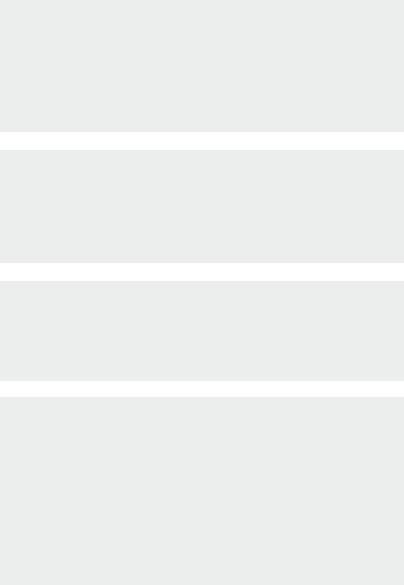
WARNING!
READ THIS MANUAL! Carefully read this instruction manual in its entirety paying close attention to all warnings listed below, including section 1.1. “Safety Precautions”. Make sure that you fully understand the use, displays and limitations of the dive computer because any confusion resulting from neglecting to follow this instruction manual or from improper use of this device may cause a diver to commit errors that may lead to serious injury or death.
WARNING!
NOT FOR PROFESSIONAL USE! Suunto dive computers are intended for recreational use only. The demands of commercial or professional diving may expose the diver to depths and exposures that tend to increase the risk of decompression illness (DCI). Therefore, Suunto strongly recommends that the device be not used for commercial or professional diving activity.
WARNING!
ONLY DIVERS TRAINED IN THE PROPER USE OF SCUBA DIVING EQUIPMENT SHOULD USE A DIVE COMPUTER! No dive computer can replace the need for proper dive training. Insufficient or improper training may cause diver to commit errors that may lead to serious injury or death.
WARNING!
THERE IS ALWAYS A RISK OF DECOMPRESSION ILLNESS (DCI) FOR ANY DIVE PROFILE EVEN IF YOU FOLLOW THE DIVE PLAN PRESCRIBED BY DIVE TABLES OR A DIVE COMPUTER. NO PROCEDURE, DIVE COMPUTER OR DIVE TABLE WILL PREVENT THE POSSIBILITY OF DCI OR OXYGEN TOXICITY! An individual’s physiological make up can vary from day to day. The dive computer cannot account for these variations. You are strongly advised to remain well within the exposure limits provided by the instrument to minimize the risk of DCI. As an added measure of safety, you should consult a physician regarding your fitness before diving.
3
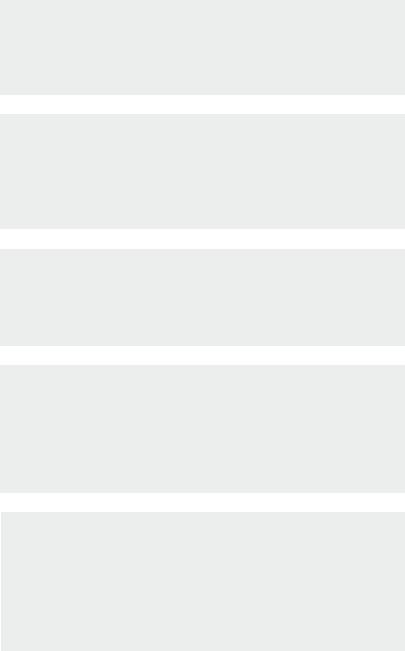
WARNING!
SUUNTO STRONGLY RECOMMENDS THAT SPORT DIVERS LIMIT THEIR MAXIMUM DEPTH TO 40 M [130 FT] OR TO THE DEPTH CALCULATED BY THE COMPUTER BASED ON THE SELECTED O2% AND A MAXIMUM PO2 OF 1.4 BAR!
WARNING!
DIVES WITH REQUIRED DECOMPRESSION STOPS ARE NOT RECOMMENDED. YOU SHOULD ASCEND AND BEGIN DECOMPRESSION IMMEDIATELY WHEN THE DIVE COMPUTER SHOWS YOU THAT A DECOMPRESSION STOP IS REQUIRED! Note the blinking ASC TIME symbol and the upward pointing arrow.
WARNING!
USE BACK-UP INSTRUMENTS! Make sure that you use back-up instrumentation including a depth gauge, submersible pressure gauge, timer or watch, and have access to decompression tables whenever diving with the dive computer.
WARNING!
PERFORM PRECHECKS! Always activate and check the device before diving in order to ensure that all Liquid Crystal Display (LCD) segments are completely displayed, that the device has not run out of battery power, and that the oxygen, altitude and personal adjustments are correct. Also, exit the PC Settings (PC SET) sub-mode before diving, as the computer does not automatically revert to Dive mode from the PC Settings mode.
WARNING!
YOU ARE ADVISED TO AVOID FLYING ANY TIME THE COMPUTER COUNTS DOWN THE NO-FLYING TIME. ALWAYS ACTIVATE THE COMPUTER TO CHECK THE REMAINING NO-FLY TIME PRIOR TO FLYING! The computer goes into the stand-by display automatically 5 minutes after the dive has ended. The stand-by display shuts off after two hours. Flying or traveling to a higher altitude within no-fly time can greatly increase the risk of DCI. Review the recommendations given by Diver’s Alert Network (DAN)
4
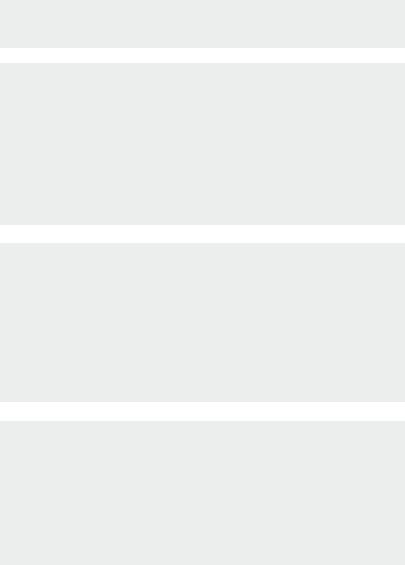
in chapter 3.5.3. “Flying After Diving”. There can never be a flying after diving rule that is guaranteed to completely prevent decompression illness!
WARNING!
THE DIVE COMPUTER SHOULD NEVER BE TRADED OR SHARED BETWEEN USERS WHILE IT IS IN OPERATION! Its information will not apply to someone who has not been wearing it throughout a dive or sequence of repetitive dives. Its dive profiles must match that of the user. If it is left on the surface during any dive, it will give inaccurate information for subsequent dives. No dive computer can take into account dives made without the computer. Thus any diving activity up to four days prior to initial use of the computer may cause misleading information and must be avoided.
WARNING!
THE DIVE COMPUTER WILL NOT ACCEPT FRACTIONAL PERCENTAGE VALUES OF OXYGEN CONCENTRATION. DO NOT ROUND UP FRACTIONAL PERCENTAGES! For example, 31.8% oxygen should be entered as 31%. Rounding up will cause nitrogen percentages to be understated and will affect decompression calculations. If there is a desire to adjust the computer to provide more conservative calculations, use the personal adjustment feature to affect decompression calculations or reduce the PO2 setting to affect oxygen exposure.
WARNING!
SET THE CORRECT ALTITUDE ADJUSTMENT MODE! When diving at altitudes greater than 300 m [1000 ft] the Altitude Adjustment feature must be correctly selected in order for the computer to calculate the decompression status. The dive computer is not intended for use at altitudes greater than 3000 m [10000 ft]. Failure to select the correct Altitude Adjustment setting or diving above the maximum altitude limit will result in erroneous dive and planning data.
5

WARNING!
SET THE CORRECT PERSONAL ADJUSTMENT MODE! Whenever it is believed that factors that tend to increase the possibility of DCI exist, it is recommended that you use this option to make the calculations more conservative. Failure to select the correct Personal Adjustment setting will result in erroneous dive and planning data.
NOTE!
You can change from Air mode to Nitrox mode at any time. It is however not possible to revert back to Air mode from Nitrox mode before the instrument has counted down the no-flying time.
When planning both air and nitrox dives during the same dive series, you should set the instrument in Nitrox mode and modify the gas mix accordingly.
6
TABLE OF CONTENTS |
|
WARNINGS.................................................................................... |
3 |
1. INTRODUCTION...................................................................... |
9 |
1.1. SAFETY PRECAUTIONS............................................................ |
10 |
1.1.1. Emergency Ascents................................................................... |
10 |
1.1.2. Dive Computer Limitations...................................................... |
11 |
1.1.3. Nitrox........................................................................................ |
11 |
2. GETTING ACQUAINTED...................................................... |
12 |
2.1. FUNCTIONS................................................................................. |
12 |
2.2. PUSH BUTTONS.......................................................................... |
12 |
2.3. WATER CONTACTS..................................................................... |
14 |
3. DIVING WITH THE ZOOP................................................... |
15 |
3.1. BEFORE DIVING......................................................................... |
15 |
3.1.1. Activation and Prechecks.......................................................... |
15 |
3.1.2. Battery Indication..................................................................... |
17 |
3.1.2.1. Battery Power Indicator.............................................. |
17 |
3.1.3. Dive Planning [PLAN]............................................................. |
18 |
3.1.4. User Definable Functions and Alarms...................................... |
19 |
3.2. SAFETY STOPS............................................................................ |
19 |
3.2.1. Recommended Safety Stop...................................................... |
19 |
3.2.2. Mandatory Safety Stop............................................................. |
19 |
3.3. DIVING WITH THE ZOOP.......................................................... |
20 |
3.3.1. Basic Dive Data........................................................................ |
20 |
3.3.2. Bookmark................................................................................. |
21 |
3.3.3. Consumed Bottom Time (CBT)............................................... |
22 |
3.3.4. Ascent Rate Indicator............................................................... |
22 |
3.3.5. Decompression dives................................................................ |
23 |
3.4. DIVING IN NITROX MODE........................................................ |
27 |
3.4.1. Before Diving........................................................................... |
27 |
3.4.2. Oxygen Displays...................................................................... |
28 |
3.4.3. Oxygen Limit Fraction (OLF).................................................. |
29 |
3.5. AT THE SURFACE........................................................................ |
30 |
3.5.1. Surface Interval......................................................................... |
30 |
3.5.2. Dive Numbering....................................................................... |
31 |
3.5.3. Flying After Diving.................................................................. |
31 |
7
3.6. AUDIBLE AND VISUAL ALARMS............................................ |
33 |
3.7. HIGH ALTITUDE DIVES AND PERSONAL ADJUSTMENT...34 |
|
3.7.1. Altitude Adjustment.................................................................. |
34 |
3.7.2. Personal Adjustment................................................................. |
35 |
3.8. ERROR CONDITIONS................................................................. |
36 |
4. MENU BASED MODES.......................................................... |
37 |
4.1. MEMORY FUNCTIONS [1 MEMORY]...................................... |
38 |
4.1.1. Logbook and Dive Profile Memory [1 LOGBOOK]................ |
39 |
4.1.2. Dive History Memory [2 HISTORY]....................................... |
42 |
4.1.3. Data Transfer and PC-Interface [3 PC-SET]............................ |
42 |
4.2. SET MODES [2 SET].................................................................... |
44 |
4.2.1. Dive Computer Model Settings[1 SET MODEL ]................... |
44 |
4.2.1.1. Nitrox Oxygen Settings.............................................. |
44 |
4.2.2. Alarm settings [2 SET ALMS]................................................. |
45 |
4.2.2.1. Dive Time Alarm Setting............................................ |
45 |
4.2.2.2. Maximum Depth Alarm Setting.................................. |
45 |
4.2.3. Setting Time and date [3 SET TIME]....................................... |
46 |
4.2.4. Personal adjustments [4 SET ADJ].......................................... |
47 |
5. CARE AND MAINTENANCE OF MY SUUNTO |
|
DIVING COMPUTER............................................................. |
48 |
5.1. BATTERY REPLACEMENT........................................................ |
50 |
6. TECHNICAL DESCRIPTION............................................... |
54 |
6.1. OPERATING PRINCIPLES.......................................................... |
54 |
6.2. SUUNTO REDUCED GRADIENT BUBBLE MODEL |
|
(RGBM)......................................................................................... |
56 |
6.3. OXYGEN EXPOSURE................................................................. |
57 |
6.4. TECHNICAL SPECIFICATION................................................... |
57 |
7.SUUNTO LIMITED WARRANTY FOR SUUNTO DIVING COMPUTERS AND SUUNTO DIVING
COMPUTER ACCESSORIES................................................ |
61 |
8. Suunto Dive Manager (SDM)...................................... |
65 |
9. GLOSSARY.............................................................................. |
66 |
8
1. INTRODUCTION
Congratulations on your purchase of the SUUNTO ZOOP dive computer. The ZOOP builds on the Suunto tradition of delivering feature-rich easy-use dive computers. Push button controls access a wide selection of choices and the display is optimized for the dive mode chosen. This dive computer is a compact and sophisticated multipurpose dive instrument, designed to give you years of trouble-free service.
Choice of Operating Modes and Set-up Options
User options for the ZOOP are selected using the push buttons.
Pre Dive configuration and setup options include:
•Choice of operating mode - Air / Nitrox
•Choice of unit - Metric / Imperial
•Maximum depth alarm
•Dive time alarm
•Clock, calendar
•Mix Oxygen fraction % (Nitrox mode only)
•Maximum PO2 (Nitrox mode only)
•Altitude adjustment
•Personal adjustment
Continuous Decompression with Suunto RGBM
The Suunto Reduced Gradient Bubble Model (RGBM) utilized in the ZOOP predicts both dissolved and free gas in blood and tissues of divers. It is a significant advance on the classic Haldane models, which do not predict free gas. The advantage of Suunto RGBM is additional safety through its ability to adapt to a variety of situations and dive profiles.
In order to optimize how to respond to different added risk situations an additional category of stop, referred to as a Mandatory Safety Stop, has been introduced. Also a countdown for the Recommended Safety Stop is included. The combination of stop types will depend on the specific dive situation.
To get the most from the safety benefits be sure to read the summary of the Reduced Gradient Bubble Model in chapter 6.2.
9
1.1. SAFETY PRECAUTIONS
Do not attempt to use the dive computer without reading this instruction manual in its entirety, including all the warnings. Make sure that you fully understand the use, displays and limitations of the instrument. If you have any questions about the manual or the dive computer, contact your SUUNTO dealer before diving with the dive computer.
Always remember that YOU ARE RESPONSIBLE FOR YOUR OWN SAFETY!
When used properly, the dive computer is an outstanding tool for assisting properly trained, certified divers in planning and executing sport dives. It is NOT A SUBSTITUTE FOR CERTIFIED SCUBA INSTRUCTION, including training in the principles of decompression.
Diving with enriched air mixtures (nitrox) exposes the user to risks different from those associated with diving with standard air. These risks are not obvious and require training to understand and avoid. Risks include possible serious injury or death.
Do not attempt to dive with any gas mix other than standard air without first receiving certified training in this specialty.
1.1.1. Emergency Ascents
In the unlikely event that the dive computer malfunctions during a dive, follow the emergency procedures provided by your certified dive training agency or, alternatively,
STEP 1: Assess the situation calmly and then move promptly to less than 18 m [60 ft].
STEP 2: At 18 m [60 ft], slow down your ascent rate to 10 m/min [33 ft/min] and move to a depth between 3 and 6 meters [10 to 20 ft].
STEP 3: Stay there as long as you assess your air supply will safely allow. After reaching the surface stay out of the water for at least 24 hours.
10
1.1.2. Dive Computer Limitations
While the dive computer is based on current decompression research and technology, you must realize that the computer cannot monitor the actual physiological functions of an individual diver. All decompression schedules currently known to the authors, including the U.S. Navy Tables, are based on theoretical mathematical models, which are intended to serve as a guide to reduce the probability of decompression illness.
1.1.3. Nitrox
Diving with nitrox provides the diver with an opportunity to increase bottom times or reduce the risk of decompression illness by reducing the nitrogen content in the breathing gas mix.
However, when the gas mix is altered, the oxygen content of the mix is generally increased. This increase exposes the diver to an oxygen toxicity risk not usually considered in recreational diving. In order to manage this risk, the dive computer tracks the time and intensity of the oxygen exposure and provides the diver with information to adjust the dive plan in order to maintain oxygen exposure within reasonably safe limits.
In addition to the physiological effects of enriched air on the body there are operational considerations to be addressed when handling altered breathing mixes. Elevated concentrations of oxygen present a fire or explosion hazard. Consult the manufacturer of your equipment in regards to its compatibility with nitrox.
11
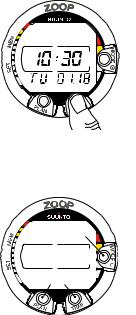
2. GETTING ACQUAINTED
2.1. FUNCTIONS
The Suunto ZOOP can be set to function as a regular air dive computer or as a nitrox dive computer.
The ZOOP features two dive computer models (AIR, NITROX), three main operating modes (TIME/STAND-BY, SURFACE, DIVING), two menu based main modes (MEMORY, SET) and seven menu based submodes (review separate Quick Reference Guide).You can scroll through the modes using the push buttons. The mode indicator at the left side and the mode text at the bottom of the display indicate the selected mode.
The timekeeping display is the default display of the instrument (Fig. 2.1.). If a button is not pressed within 5 minutes, the dive computer beeps and returns to the timekeeping display automatically (except in Diving mode). The timekeeping display shuts off after two hours, but pressing the PLAN or TIME button activates it.
Fig. 2.1. Timekeeping display. Pressing PLAN or TIME button activates display.
Making the ZOOP Personal
For best use of the ZOOP take some time and make it YOUR computer.
Set the correct time and date. Read this manual. Set dive alarms and make all the other settings listed in the introduction in this manual. Install the ZOOP in your console or fit it on to your wrist.
All this so you know your computer and have it set up as you want it before getting into the water.
The SMART button
The PLAN, TIME and
SCROLL buttons
Fig. 2.2. Push buttons of the dive computer.
2.2. PUSH BUTTONS
The ZOOP has easy-to-use push buttons and an advisory display, which guides the user. The SMART (MODE) button is the key to the system. The two scroll buttons, PLAN and TIME, are used for scrolling up and down the menus and to show the alternative displays. The dive computer is controlled with these three push buttons as follows (see Fig. 2.2.).
12
Press the SMART (MODE) button
•To activate the dive computer.
•To change from the Surface Mode to the menu based modes.
•To select, confirm or quit a submode (short press).
•To immediately exit any submode to the
Surface Mode (long press).
Press the arrow up scroll (PLAN) button
•To activate the timekeeping display, if the display is blank.
•To activate the Dive Planning in the Surface
Mode.
•To make a special bookmark in the profile memory during a dive.
•To scroll up the options (, increase).
Press the arrow down scroll (ALTER) button
•To activate the timekeeping display, if the display is blank.
•To activate the alternative display(s).
•To scroll down the options (, decrease).
The dive computer is controlled with the SMART (MODE/On/Select/OK/Quit) and the PLAN and TIME push buttons and with the water contacts as follows:
Activation |
press the SMART (On) button |
|
or immerse the instrument |
|
in water for five (5) seconds. |
Dive |
|
Planning |
in the Surface Mode, press the |
|
PLAN (s) button. |
Menu Modes |
press the SMART (MODE) |
|
button. |
13
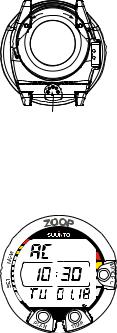
E |
O |
S |
|
O |
P |
E |
|
L |
N |
C |
|
 B
B
A
Fig 2.3. Depth sensor (A), water/data transfer contacts
(B).
2.3. WATER CONTACTS
The water contacts control the automatic activation of the Dive Mode.
The water and data transfer contacts are located on bottom of the case (Fig 2.3). When submerged the water contacts are connected to the push buttons (which are the other pole of the water contact) by the conductivity of the water. The “AC” text (Active Contacts, Fig. 2.4.) will appear on display. The AC text will be shown until the water contact deactivates or the dive computer enters the Dive Mode automatically.
Fig. 2.4. Active water contacts are indicated by the text AC.
14

3. DIVING WITH THE ZOOP
This section contains instructions on how to operate the dive computer and interpret its displays.You will find that this dive computer is easy to use and read. Each display shows only the data relevant to that specific diving situation.
3.1. BEFORE DIVING
3.1.1. Activation and Prechecks
The dive computer will activate if submerged deeper than 0.5 m (1.5 ft). However, it is necessary to turn on the Dive Mode before diving to check the altitude and personal adjustment settings, battery condition, oxygen settings etc. Press the SMART (Mode) button to activate the instrument.
After activation all display elements will turn on showing mostly figure 8’s and graphical elements (Fig. 3.1.). A few seconds later the battery power indicator is shown and the buzzer is activated (Fig. 3.2. display a, b, c or d depending on the battery voltage). If set to Air mode the screen will enter the Surface mode (Fig. 3.3.) and if set to Nitrox mode the essential oxygen parameters are shown with the text NITROX (Fig. 3.20.) before the Surface mode.


 °C
°C
Fig. 3.1. Startup I. All segments shown.
Fig. 3.2. Startup II. Battery power indicator.
15

m
ºC |
DIVE TIME |
TIME
Fig 3.3. Startup III. Surface mode. Depth and dive time are zero, current temperature, 20 °C. Pressing TIME button activates alternative display of current time.
|
m |
ºC |
DIVE TIME |
Fig. 3.4. Low Battery Warning. Battery symbol indicates that the battery is low and battery replacement is recommended.
At this time, perform your prechecks making sure that:
•the instrument operates in the correct mode and provides a complete display (Air/Nitrox modes)
•the low battery indicator is not on
•the altitude and personal adjustment set- tings are correct
•the instrument displays correct units of measurement (Metric/Imperial)
•the instrument displays correct temperature and depth (0.0 m [0 ft])
•the buzzer beeps
And if set to Nitrox mode (refer to chapter 3.4 Diving in Nitrox mode), make sure that:
•the oxygen percentage is adjusted accord- ing to the measured Nitrox blend in your cylinder
•the oxygen partial pressure limit is set cor- rectly.
The dive computer is now ready for diving.
DIVE
MAX

 QUIT
QUIT
NO DEC TIME
Fig. 3.5. Dive Planning. Planning mode is indicated by PLAN text. No-decom- pression time limit at 30.0 m [100 ft] is 14 minutes in A0/P1 mode.
16
3.1.2. Battery Indication
3.1.2.1. Battery Power Indicator
This dive computer has a unique graphic Battery Power Indicator designed to give you an advance notice of impending need to change the battery.
The Battery Power Indicator can always be seen when the Dive Mode is activated. The following Table and Figure show the various warning levels.
TABLE 3.1. BATTERY POWER INDICATOR
Display |
Operation |
Figure 3.2 |
|
|
|
BAT + |
Normal, full battery. |
a |
4 segments + OK |
|
|
|
|
|
BAT + |
Normal, battery power is getting |
b |
3 segments |
low or the temperature is low. |
|
|
Battery replacement is recommended |
|
|
if you are going to colder conditions |
|
|
or if you are planning to make a dive trip. |
|
|
|
|
LOWBAT + |
Battery power is low and the battery |
c |
2 segments + |
replacement is recommended. |
|
low battery symbol |
The battery symbol is displayed. |
|
|
|
|
LOWBAT + |
Change the battery! |
d |
1 segments + QUIT+ |
Returns to the Time display. |
|
low battery symbol |
Activation and all functions are disabled. |
|
|
|
|
Temperature or an internal oxidation of the battery affects the battery voltage. If the instrument is stored for a long period, the low battery warning may be displayed even though the battery has enough capacity. The low battery warning may also be displayed at low temperatures, even though the battery has enough capacity in warmer conditions. In these cases repeat the battery check procedure.
After battery check the Low Battery Warning is indicated by the battery symbol (Fig. 3.4.).
If the battery symbol is displayed in the Surface mode or if the display is faded or weak, the battery may be too low to operate the dive computer and battery replacement is recommended.
17
3.1.3. Dive Planning [PLAN]
To enter Planning Mode, press the PLAN button at any time during Surface Mode. After showing the text “PLAN” (Fig. 3.5.), the display will show the nodecompression limit for the depth of 9 m [30 ft]. By pressing the down arrow () (TIME) button, the dive computer will calculate and show the next deeper no-decompression limits in 3 m [10 ft] increments ending at 45 m [150 ft]. By pressing the up arrow () (PLAN) button, the next shallower depth will be shown again.
The Planning Mode is canceled by pressing the SMART (QUIT) button.
NOTE! The Planning mode is disabled in Error mode (see section 3.8. “Error Conditions”).
Higher Altitude and conservative Personal Adjustment Modes will shorten the no-decompression time limits. These limits at different Altitude and Personal Adjustment Mode selections are shown in Table 6.1 and 6.2 in section 6.1. “Operating Principles”.
The Planning mode also accounts for the following information from previous dives:
•any calculated residual nitrogen
•all dive history for the past four days
•oxygen toxicity (Nitrox mode)
The no-decompression times given for different depths will therefore be shorter than before your first “fresh” dive.
DIVE NUMBERING SHOWN DURING DIVE PLANNING
Dives belong to the same repetitive dive series if the instrument was still counting down the no-fly time at the beginning of the dive.
The surface interval must be at least 5 minutes for a dive to be considered a repetitive dive. Otherwise, it is considered a continuation of the same dive. The dive number will not change and the dive time will continue where it left off (see also section 3.5.2. “Dive Numbering”).
3.1.4. User Definable Functions and Alarms
The ZOOP has several user definable functions and depth and time related alarms that you can set according to your personal preference.
18
The dive computer model (Air/Nitrox) can be set in the MODESET- MODEL submode. The dive alarms can be set under MODESET- SET ALARMS, the time and date settings in MODE-SET-SET TIME, and the units (metric/imperial) as well as personal adjustments in the MODESET- SET ADJUSTMETS submode. Setting of the user definable functions and alarms are explained in detail in section 4.2. “Set Modes”.
3.2. SAFETY STOPS
Safety stops are widely considered “good diving practice” and are an integral part of most dive tables. Reasons to perform a safety stop include a reduction in sub clinical DCI, microbubble reduction, ascent control, and orientation before surfacing.
The ZOOP displays two different types of safety stops: Recommended Safety Stop and Mandatory Safety Stop.
The Safety Stops are indicated by:
-STOP label, when in the depth range 3 m - 6 m [10 ft - 20 ft] = Recommended Safety Stop Countdown
-STOP+ CEILING label, when in the depth range 3 m - 6 m [10 ft - 20 ft] = Mandatory Safety Stop Time display
-STOP label, when deeper than 6 m = Mandatory Safety Stop scheduled
3.2.1. Recommended Safety Stop
With every dive over 10 meters the instrument has a three minute countdown for the recommended safety stop, to be taken in the 3 - 6 meter [10 ft - 20 ft] range. This is shown with the STOP sign and a three-minute countdown in the center window instead of the no-decompression time (Fig. 3.9.).
The Recommended Safety Stop, as the name implies, is recommended. If it is ignored, there is no penalty applied to the following surface intervals and dives.
3.2.2. Mandatory Safety Stop
When the ascent rate exceeds 12 meters/min [40 ft] momentarily or 10 meters/ min [33 ft] continuously the micro-bubble build-up is predicted to be more than allowed for in the decompression model. The Suunto RGBM calculation model responds to this by adding a Mandatory Safety Stop to the dive. The time of this Mandatory Safety Stop will depend on the severity of the ascent rate excess.
The STOP sign will appear in the display and when you reach the depth zone
19
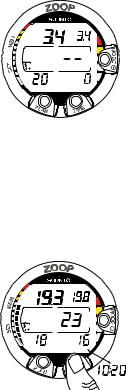
m
|
|
MAX |
|
|
NO DEC TIME |
C |
|
|
B |
|
|
T |
ºC |
DIVE TIME |
|
Fig. 3.6. Dive starts
m
|
|
MAX |
|
|
NO DEC TIME |
C |
|
|
B |
|
|
T |
ºC |
DIVE TIME |
|
Fig. 3.7. Diving display. Present depth is 19.3 m [63 ft] and no-decompression stop time limit is 23 minutes in A0/P1 mode. Maximum depth during this dive
was 19.8 m [65 ft], water temperature is 18°C [64°F], elapsed dive time is 16 minutes. Alternative display of current time 10:20 [10:20 am] is shown for 5 seconds after pressing TIME button.
between 6 m to 3 m [20 ft to 10] also the CEILING label, ceiling depth and the calculated Safety Stop time appear in the display. You should wait until the Mandatory Safety Stop warning disappears (Fig. 3.13.).
The Mandatory Safety Stop time always includes the three minute Recommended Safety Stop time. The total length of the Mandatory Safety Stop time depends on the seriousness of the ascent rate violation.
You must not ascend shallower than 3 m [10 ft] with the Mandatory Safety Stop warning on. If you ascend above the Mandatory Safety Stop ceiling, a downward pointing arrow will appear and a continuous beeping starts (Fig. 3.14.).You should immediately descend to, or below, the Mandatory Safety Stop ceiling depth. If you correct this situation at any time during that dive, there are no affects on the decompression calculations for future dives.
If you continue to violate the Mandatory Safety Stop, the tissue calculation model is affected and the dive computer shortens the available no-decompression time for your next dive. In this situation, it is recommended to prolong your surface interval time before your next dive.
3.3. DIVING WITH THE ZOOP
The ZOOP has two operating modes: Air mode for diving with standard air only and Nitrox mode for diving with oxygen enriched (EANx) mixtures. The Nitrox mode is enabled in the MODE-SET-MODEL.
3.3.1. Basic Dive Data
The dive computer will remain in the Surface mode at depths less than 1.2 m [4 feet]. At depths greater than 1.2 m the instrument will go into the Diving mode (Fig. 3.6.).
20
